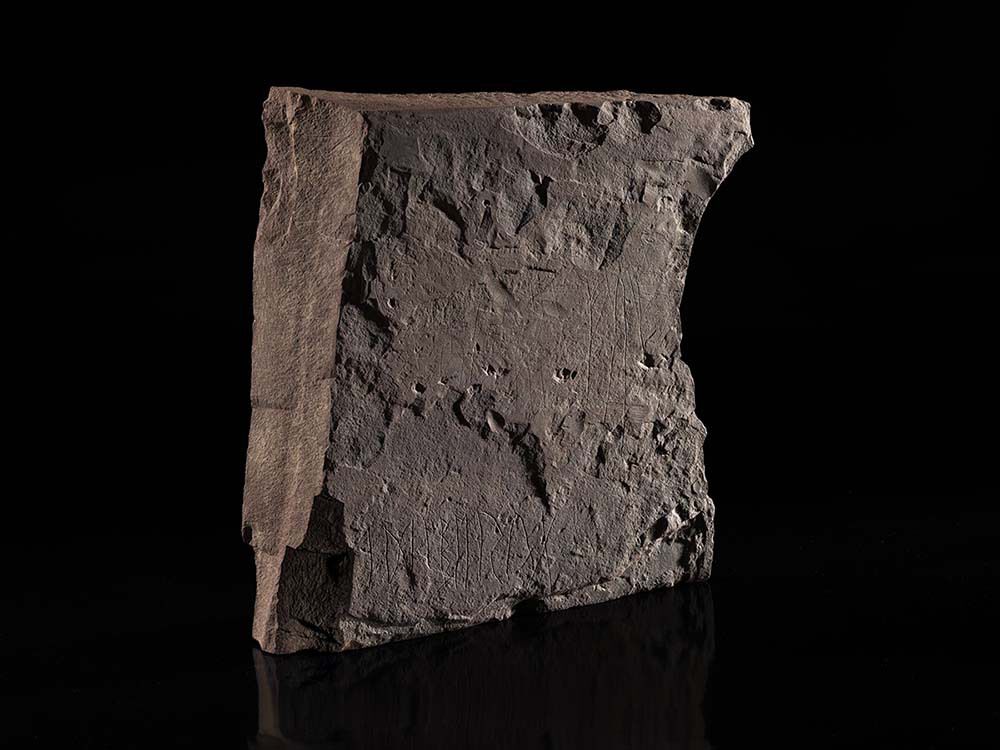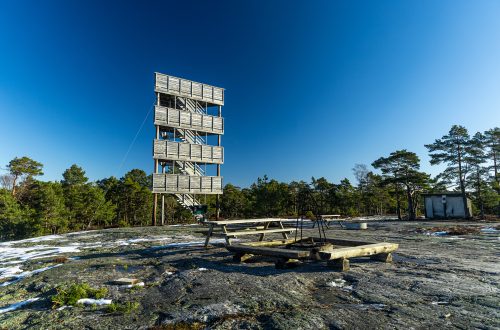
Historisk Museum
Muzeum Historyczne w Oslo znalazło się na mojej liście miejsc do odwiedzenia tej zimy. Byłem zainteresowany głównie wystawie poświęconej wikingom i znaleziskom archeologicznym z tamtego okresu, ale nie zamierzałem ignorować pozostałych ekspozycji. Moja wizyta zgrała się w czasie z odsłonięciem najnowszego eksponatu, który postanowiono pokazać odwiedzającym zaledwie tydzień wcześniej, najstarszego kamienia runicznego, jaki do tej pory odnaleziono. Liczyłem, że rzucę okiem i na to.
Muzeum mieści się w centrum Oslo, rzut beretem od rezydencji królewskiej. Na miejsce dotarłem tuż przed otwarciem w niedzielne przedpołudnie. Bilet dla osoby dorosłej uszczuplił mój portfel o 120 koron.
Pierwsza sala to eksponaty z epoki kamienia łupanego. Większe i mniejsze kamienie, noszące ślady obróbki ręką człowieka umieszczono w zgrabnych gablotkach. Interesująco przedstawiają się równo ociosane groty strzał, wykonane z kości haczyki na ryby czy pęknięty amulet.
W tej samej Sali znalazły się również eksponaty z odległej Polinezji i starożytnej cywilizacji wysp Oceanu Spokojnego. Zastanawiałem się, czy owa ekspozycja ma coś wspólnego ze słynną wyprawą Kon-Tiki Thora Heyerdahla. Może to on sam przywiózł wszystkie te fanty ze swoich podróży. Nie znalazłem na te pytania odpowiedzi.
Kolejne pomieszczenie przywitało mnie przedmiotami codziennego użytku, odnalezionymi w różnych miejscach Norwegii. Skoncentrowano się głównie na elementach rolniczych i obecności zwierząt hodowlanych w życiu człowieka. Wiele eksponatów pochodzi jeszcze sprzed epoki wikingów.
Na piętrze znalazły się ekspozycje dotyczące życia etnicznych plemion polarnych: Inuitów i ludów zamieszkujących obszary Syberii. Możemy więc dowiedzieć się jak wygląda wnętrze tradycyjnego igloo, o sposobach polowań i kim byli inuiccy szamani. Dodatkowo na sporych tablicach poczytać można o sposobach wytwarzania tradycyjnych inuickich ubrań. Obecnie produkcją takiej odzieży zajmują się mieszkańcy założonej przez Roalda Amundsena (ponad 100 lat temu) osady Gjoa Haven.
Sąsiednia sala poświęcona jest ludom obu ameryk. Przeważają stroje i przedmioty codziennego użytku. Zaraz obok możemy rzucić okiem na dwa sarkofagi oraz kilkanaście przedmiotów pochodzących ze starożytnego Egiptu. Są więc figurki skarabeuszy, biżuteria, posążki egipskich bóstw.
A dalej wystawa poświęcona złotu. Wystawa pokazuje wybrane złote monety sprzed 2600 lat, ale pokazuje też, jak na przykład żywy inwentarz był używany jako pieniądz, zanim monety i banknoty weszły do obiegu. Zobaczyć tu można złote monety, medale i odznaczenia (także te, które otrzymali Fridtjof Nansen i Roald Amundsen za swoje osiągnięcia). Uwagę zwraca kontener wyłożony 15 000 złotymi monetami. Jest to własność Banku Norweskiego i stanowi część rezerwy narodowej. Za wszystkim kryje się ciekawa historia. 9 kwietnia 1940, tuż po napaści Niemiec na Norwegię, całą rezerwę złota z Banku Narodowego w Oslo (55 ton w złocie i 12 milionów w gotówce) wywieziono potajemnie, aby nie dostała się w ręce okupanta. W operację zaangażowano wojsko ale również i cywilów używając pociągu, ciężarówek i łodzi. Ładunek załadowano ostatecznie na brytyjskie statki w zachodniej i północnej Norwegii i wywieziono do Anglii, Stanów Zjednoczonych i Kanady. Historię można by opisać w osobnym wpisie, ale lepiej obejrzeć o tym film (Gulltransporten z 2022 roku).
Kolejne piętro i kolejne dwie wystawy. Pierwsza to antyczne rzeźby, przedmioty ze starożytnego Egiptu, Grecji i Cesarstwa Rzymskiego. Znajdują się tu sarkofagi, popiersia, płaskorzeźby, wazony czy niewielki kawałek egipskiego papirusu.
I wreszcie crème de la crème czyli ekspozycja poświęcona wikingom. Wystawa VÍKINGR pokazuje znane i wykwintne przedmioty, które reprezentują różne aspekty życia, śmierci i społeczeństwa. Tutaj mamy do czynienia nie tylko z elementami wyposażenia wojowników. Te, oczywiście również tu są. Miecze, hełmy, ostrza włóczni czy fragment koszulki kolczej sprawiają ogromne wrażenie. Ale oprócz tego wszystkiego możemy obejrzeć złote bądź srebrne ozdoby, brosze, pierścienie naramienne, noszone jako oznaka prestiżu.
W osobnym pomieszczeniu znalazł się wspomniany już na początku najstarszy kamień runiczny. Odnaleziony w 2021 roku na cmentarzysku nad Tyrifiordem, na północny zachód od Oslo, w miejscowości Svingerud, datowany jest na okres 1 – 250 r n.e. Obiekt na cześć miejsca jego odnalezienia nazywany jest Svingerudsteinen. Czerwonawo-brązowy kamień ma wymiary 31 na 32 cm i wyraźnie widoczne są na nim znaki runiczne, wyryte jakimś ostrym narzędziem. Do tej pory uczonym udało się odczytać jedynie widniejące na nim kobiece imię: Idibera. Nie wiadomo natomiast jakie jest przesłanie całego napisu. Być może, że pozostały ciąg znaków był tylko zabawą i wprawianiem się w stawianie liter.
Wszystkie zdjęcia kamienia runicznego Svingerudsteinen są własnością Muzeum Historii w Oslo.
Moją wizytę w muzeum zakończyłem z lekkim niedosytem. Liczyłem na nieco więcej, zwłaszcza jeśli chodzi o wystawę VÍKINGR. Dopiero po powrocie do domu wyczytałem na oficjalnej stronie muzeum, że:
- Eksponaty wystawy VÍKINGR zostały jedynie wypożyczone przez Viking Ship Museum na czas trwania przebudowy tego ostatniego. Otwarcie nowego muzeum ma mieć miejsce dopiero w 2026 roku, i część przedmiotów do tego czasu będzie można obejrzeć właśnie w Muzeum Historycznym.
- Wszystkie wystawy w Muzeum Historii mają charakter tymczasowy. Oznacza to, że co jakiś czas jest szansa na zobaczenie czegoś nowego, warto więc od czasu do czasu sprawdzać stronę internetową by ewentualnie zaplanować kolejna wizytę.
The Historical Museum in Oslo was on my list of places to visit this winter. I was mainly interested in the Vikings and archaeological exhibition from that period, but I wasn’t going to ignore the other exhibits. My visit coincided with the unveiling of the newest exhibit, which had been decided to show visitors only a week earlier, the oldest runestone that had been found so far. I was hoping to take a look at that as well.
The museum is located in the center of Oslo, a stone’s throw from the royal residence. I got there just before opening on Sunday morning. An adult ticket reduced my wallet by 120 krons.
I started from exhibit from the Stone Age. Larger and smaller stones, bearing traces of man-made processing, were placed in glass cabinets. Evenly hewn arrowheads, fishhooks made of bone or a broken amulet look interesting.
In the same room, there are also exhibits from distant Polynesia and the ancient civilization of the islands of the Pacific Ocean. I wondered if this exhibit had anything to do with Thor Heyerdahl’s famous Kon-Tiki expedition. Maybe he himself brought all these goodies from his travels. I have not found answers to these questions.
The next room greeted me with everyday objects found in various places in Norway. The main focus was on agricultural elements and the presence of livestock in human life. Many of the exhibits date back to before the Viking Age.
On the first floor there are exhibitions about the life of ethnic polar tribes: the Inuit and peoples living in Siberia. So we can find out what the inside of a traditional igloo looks like, about hunting methods and who the Inuit shamans were. In addition, on large boards you can read about the ways of making traditional Inuit clothes. Currently, the inhabitants of the Gjoa Haven settlement founded by Roald Amundsen (over 100 years ago) are engaged in the production of such clothes.
The adjacent room is dedicated to the peoples of the Americas. Clothes and everyday items predominate. Right next to it, we can take a look at two sarcophagus and other objects from ancient Egypt. So there are figures of scarabs, jewelry, statuettes of Egyptian deities.
Next there was an exhibition dedicated to gold. The exhibition shows a selection of gold coins from 2,600 years ago, but also shows how, for example, livestock was used as money before coins and notes came into circulation. Here you can see different gold coins, medals and decorations (including those received by Fridtjof Nansen and Roald Amundsen for their achievements). Attention is drawn to the container lined with 15,000 gold coins. It is owned by the Bank of Norway and is part of the national reserve. There is an interesting story behind it. On April 9, 1940, just after Germany invaded Norway, the entire gold reserve of the National Bank in Oslo (55 tons in gold and 12 million in cash) was secretly moved to prevent it from falling into the hands of the occupiers. The operation involved the military but also civilians using trains, trucks and boats. The cargo was loaded onto British ships on Western and Northeren Norway and shipped to England, the United States and Canada. The story could be described in a separate post, but it’s better to watch a movie about it (Gulltransporten from 2022).
Another floor and two more exhibitions. The first is antique sculptures and other items from ancient Egypt, Greece and the Roman Empire. There are sarcophagi, busts, bas-reliefs, vases and a small piece of Egyptian papyrus.
And finally crème de la crème, i.e. an exhibition dedicated to the Vikings. The VÍKINGR exhibition showcases familiar and exquisite objects that represent various aspects of life, death and society. Here we are dealing not only with elements of warrior equipment. These, of course, are also here. Swords, helmets, spear blades or a fragment of a chain mail shirt make a great impression. But in addition to all this, we can see gold or silver ornaments, brooches, arm rings, worn as a sign of prestige.
In a separate room there is the oldest rune stone mentioned at the beginning. Found in 2021 in a cemetery on the Tyrifiord, northwest of Oslo, in the town of Svingerud, it is dated to the period 1 – 250 AD. The object is named Svingerudsteinen in honor of the place where it was found. The reddish-brown stone measures 31 by 32 cm and clearly shows the runes, carved with some sharp tool. So far, scientists have only been able to decipher the woman’s name on it: Idibera. However, it is not known what the message of the entire inscription is. Perhaps the remaining string of characters was just fun and practice in writting letters.
All pictures of rune stone Svingerudsteinen are Oslo Historisk Museum’s property.
I ended my visit to the museum not fully satsfied. I was hoping for a bit more, especially when it comes to the VÍKINGR exhibition. But when I only returning home and read on the official website of the museum that
- The VÍKINGR exhibits were only lent by the Viking Ship Museum for the duration of the building reconstruction. The opening of the new museum is planned in 2026, and some items will stay at the Historical Museum until then.
- All exhibitions at the History Museum are temporary. This means that time to time there is a chance to see something new, so it’s worth checking the website from regllary to plan your next visit.




























